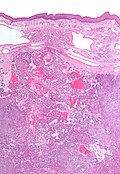Polymorphous low grade adenocarcinoma
| Polymorphous low-grade adenocarcinoma | |
|---|---|
 |
|
| Low magnification micrograph of a polymorphous low-grade adenocarcinoma, showing the typical variation of architectural arrangement. H&E stain. | |
| Classification and external resources |
Polymorphous low-grade adenocarcinoma, often abbreviated PLGA, is a rare, asymptomatic, slow-growing malignant salivary gland tumor. It is most commonly found in the palate.
The name of the tumor derives from the fact that:
It affects the minor salivary glands in the area between the hard and the soft palate. Male to female ratio is 3:1, and the average age is 56 years.
PLGAs consist of a monomorphous cell population that has a varied histologic morphology.
Microscopically, its histology can be confused with an adenoid cystic carcinoma and a pleomorphic adenoma.
PLGAs are treated with wide local surgical excision and long-term follow-up. There is a recurrence rate of 14% (Peterson, contemporary of oral and maxillofacial surgery).
Polymorphous low-grade adenocarcinoma. H&E stain.
...
Wikipedia
